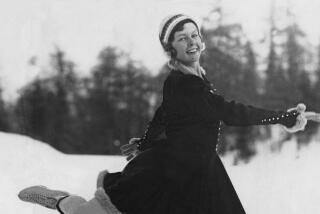Rinking In New Era of Skating Fans : Business Is Gliding Along Across U.S.
SAN DIEGO — The year was 1947, and Michael Kirby, a 22-year-old actor and sometime figure-skating teacher, was skating by himself at a West Los Angeles ice rink when the manager approached him. The manager asked Kirby if he’d like to skate with the owner of the arena.
“I told him I’d be honored to,” Kirby said.
Who wouldn’t have? The name of the arena was Sonja Henie Westside Ice Palace, and the owner, a three-time Olympic gold medalist, was one of the most famous athletes and movie stars in the world.
Henie, a national skating champion in her native Norway at age 14, had won the gold medal for figure skating in the 1928, 1932 and 1936 Olympics and had starred in a series of Hollywood films--most of them with ice-skating backdrops--when Kirby met her. It was Henie’s showmanship on ice, both in the Olympics and in movies, that helped turn ice skating into a popular recreational pastime in the United States.
Kirby’s chance meeting with the star turned out to be much more than that.
“We got along well,” said Kirby, now 63 and owner of San Diego Ice Arena. “We seemed to have similar stroking, even though she was a foot shorter than I was. The very first day I skated with her, we were skating side by side, doing some footwork, and she tripped and I caught her before she fell. She thought that was pretty good. And it was just pure luck.”
Later that day, Henie asked Kirby if he would like to work with her in an upcoming motion picture, and also invited him to join her Hollywood Ice Review, which was about to go on tour. Kirby said Henie wouldn’t have taken no for an answer even if he had been foolish enough to give it.
“She was a pretty determined person and she made up her mind,” he said.
Kirby went on tour and the next year co-starred with Henie in “The Countess of Monte Cristo.” Later, he signed a contract with MGM for a series of small roles in skating movies.
“Some of those films are still on late-night TV,” he said, laughing.
Although skating films have gone the way of many such squeaky-clean forms of entertainment, Kirby said, the movies, in combination with shows such as the Ice Capades, sparked the American public’s on-again, off-again romance with ice skating--one that is again in full swing across the country thanks to publicity for this year’s winter Olympics in Calgary, Alberta.
Kirby is trying to keep the romance alive in San Diego. He and his wife, Norah, a former Canadian champion in figure and free skating, moved to San Diego from Newport Beach in April to renovate the 14-year-old San Diego Ice Arena on Black Mountain Road, which they leased from a bankrupt owner six months ago.
The rink underwent $150,000 worth of improvements and reopened Aug. 23. Besides its new refrigeration system, the arena has two new skating teachers and a schedule of beginner classes set up with a system Kirby devised decades ago. So far, he said, San Diego is responding.
On opening night, about 3,000 people showed up to see performances by Scott Hamilton, the 1984 gold medalist in figure skating, and Todd Eldridge, the current junior world champion, followed by a free skating period for the audience.
“It astounded me that there was that interest for basically a non-event,” Kirby said.
The interest kept up during the heat wave on Labor Day weekend, when the rink drew about 1,000 people, “about three times our usual weekend business,” he said.
Business at Ice Capades Chalet at the University Towne Center shopping mall, the only other ice arena in San Diego, is also increasing, said manager Dan Despotopulos.
“My boss used to say that the Olympic year would be a peak and after that the curve would go down,” Despotopulos said. “But we have found that that’s not so. It doesn’t go up and down. We’ve been pretty steady all along, with more bumps to the increase than a decrease.”
The greater Los Angeles area is experiencing a similar increase, according to Arnie Sagarsky, general manager of Iceland rink in Paramount. Sagarsky said that, in the past two years, business at Iceland has increased about 40%.
“Even the competitive skaters need practice time on the ice,” he said. “It’s not available because there aren’t enough rinks in Southern California. It’s become a real asset for a rink owner to have a rink in Southern California.”
People are, in fact, taking to the ice across the United States, according to Justine Townsend Smith, executive director of the Ice Skating Institute of America, a nonprofit group of rink owners and managers.
“Skating has become very popular all year ‘round,” Townsend Smith said.
The number of people who took ice skating classes at the 400 nationwide rinks that belong to the institute is up 15% from the last fiscal year, to about 100,000, Townsend Smith said. Kirby, the institute’s founder, said that at least 25 million Americans skated at least once last year.
Townsend Smith said she doesn’t know how many new rinks are opening in the United States, but she’s gotten about 15 requests a month for information on building rinks this year. Many of the requests have come from the Southern states, she said. “With indoor facilities, they can operate 12 months out of the year.”
The institute is responding to the recent popularity of ice skating by publicizing October as National Ice Skating Month for the second year in a row, Townsend Smith said.
Iceland’s Sagarsky credits the resurgence of recreational ice skating in the United States to media exposure during the past few Winter Olympics. Figure skating has become one of the premiere prime-time events in television coverage, and the media focus has made instant celebrities of skaters such as Dorothy Hamill, Tai Babilonia and Brian Boitano.
“More people get involved with ice skating during the Olympics,” Sagarsky said. “This last Olympics showed at least 70% ice skating, and the balance was skiing. Because of this, our classes have increased 100%, from 200 to 300 to 400 to 600” during the past year.
A spokesman for ABC-TV, which has telecast the past few Winter Olympics, acknowledged that the network has gradually increased its coverage of figure skating in the past decade.
Kirby said some credit for the growth of skating in San Diego goes to the increased number of ice shows promoted at the San Diego Sports Arena and Sea World.
“Ice skating shows are very popular in San Diego and have shown increased popularity as each year goes by,” said Norm Smith, assistant general manager of the Sports Arena.
The World Figure Skating Tour filled the arena to its capacity of 13,100 people in May, most of them from San Diego, Smith said. The arena will host the Ice Capades on Wednesday through Sunday.
The recent success of Californian ice skaters has also drawn people to the rink, Sagarsky said.
“If a competitive skater does well, they continue on and they influence other people to be competitive skaters,” Sagarsky said, citing the impact of such Californians as Boitano, Tiffany Chin and Debi Thomas, who won the bronze medal at the Calgary Olympics.
Thomas, who is black, “has had a big influence on black people,” Sagarsky said. “There are more black people into skating than ever before,” along with other minorities that have traditionally shied away from skating, he said.
“We’re in a basically Spanish area, and we have a tremendous amount of Spanish people who are ice skating,” Sagarsky said. “Only in the past three or four years have we found it more mixed.”
Parks and recreation centers and other organizations that work with underprivileged children have been introducing lower-income people to skating, traditionally considered a “rich man’s sport,” by bringing in groups of children at discount rates, Sagarsky said.
Skaters of all incomes who become serious competitors can obtain grants from the U. S. Figure Skating Assn. and other groups to help pay for skates, which can cost $800, Sagarsky said.
At most California rinks, he said, skates can be rented, generally for a dollar or two per session. Admission fees range from $4 to $6.
Good skates can prevent some of the falls that lead to broken wrists and other injuries, Kirby said.
“Ninety-nine percent of people who say they have weak ankles are really having problems with the lacing or the fit of their skates,” he said. “They have the wrong skates, or cheap skates--that’s where the term (cheapskate) comes from.”
With proper skates and good instruction, the average skater can learn to perform techniques that only serious skaters were able to do years ago, Kirby said, noting that the sport has “improved tremendously in technique.”
For instance, skaters have been able to replace double jumps--two succeeding turns in the air--with triple and quadruple jumps because of the better teaching techniques and skates available.
Some people are drawn to the ice simply because skating is a good form of cardiovascular exercise. Kirby said his parents started him skating at age 6 to help correct a heart murmur, and he believes his continued skating has kept his heart strong.
“Last year, I had a new valve put in,” he said. “I was able to have the operation successfully because my heart had compensated for my defect through ice skating, which was a form of exercise not subject to contact or a game or a score.
“It’s self-regulating. You can go out there and skate for five minutes or five hours if you have the stamina,” he said. “But you don’t have an opponent to beat or a score to reach. The only regulation is the satisfaction that you yourself get out of it, even if that means, ‘I only fell down five times today.’ ”
More to Read
Go beyond the scoreboard
Get the latest on L.A.'s teams in the daily Sports Report newsletter.
You may occasionally receive promotional content from the Los Angeles Times.






